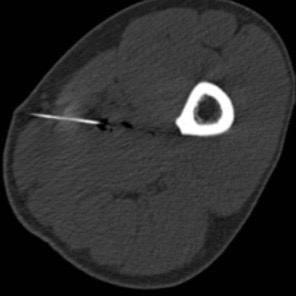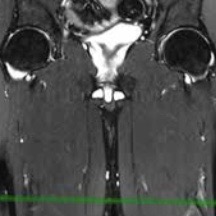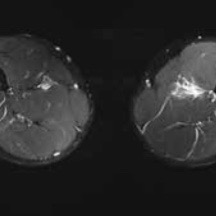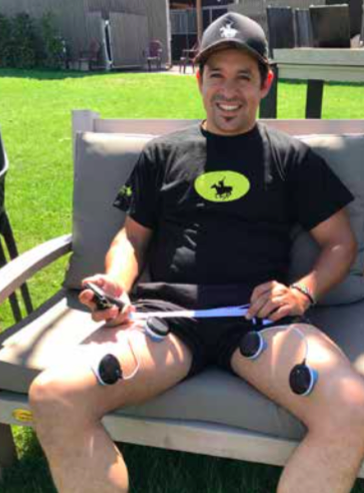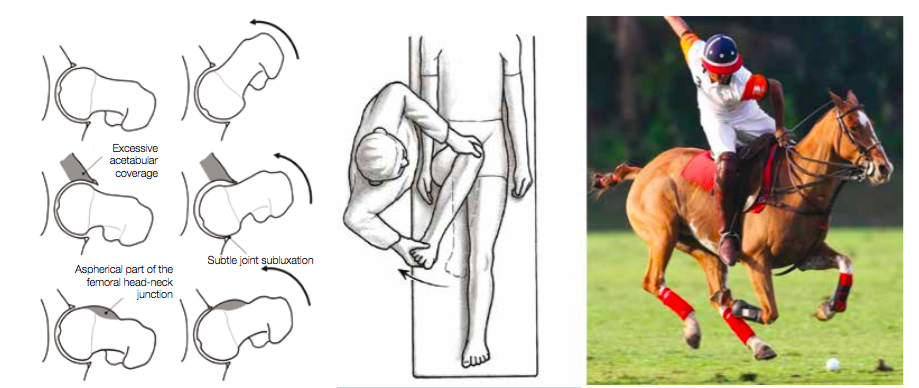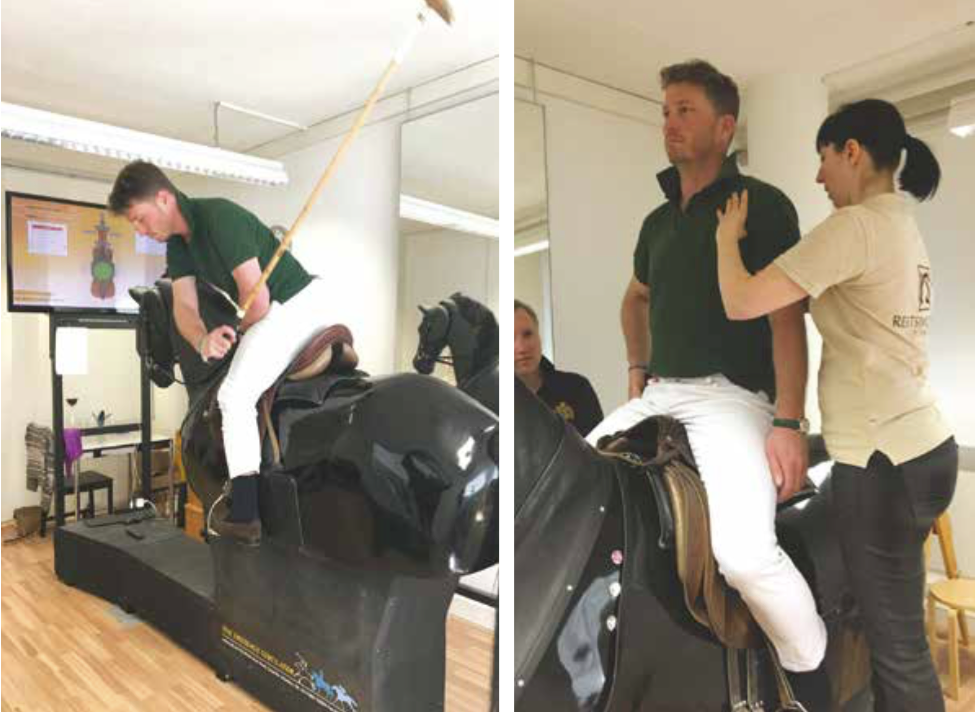
DR. MED. ANDREAS KRÜGER (MD, POLODOC)
Specialist in Orthopaedic Surgery and Traumatology FMH
Protect Your Muscles
The most common cause of groin pain is a muscle, tendon or ligament strain, particularly in athletes who play stop and go sports. Groin pain might occur immediately after an injury, or pain may come on gradually over a period of weeks or even months and will be worsened by continued use of the injured area. Less commonly, a bone injury or fracture, a hernia or even kidney stones might cause groin pain. Although testicle pain and groin pain are different, a testicle condition can sometimes cause pain that spreads to the groin area.
Tune up the brakes – Optimise the muscle
(Dr. med. Andreas Krüger @polotimes.co.uk) Polodoc Medical Insight September 2017
Stopping the horse and keeping the position in the saddle while changing direction can create extreme tension to the thigh musculature. This peak tension can damage a cold or not prepared muscle. A strain, muscle pull, or even a muscle tear refers to damage to a muscle or its attaching tendons. You can put undue pressure on muscles during normal riding, normal daily activities, with sudden heavy lifting, during sports, or while performing work tasks.
Injury pattern
Muscle damage can be in the form of tearing (part or all) of the muscle bres and the tendons attached to the muscle. The tearing of the muscle can also damage small blood vessels, causing local bleeding, or bruising and pain caused by irritation of the nerve endings in the area. Typical injury happens when the player is not warmed up and pre-riding stretching was left out, in particular, the half seat and braking, needs maximum contraction of the adductor muscles.
Symptoms of muscle strain
Swelling, bruising, or redness due to the injury
Pain at rest
Pain when the speci c muscle or the joint in relation to that muscle is used
Weakness of the muscle or tendons
Inability to use the muscle at all
Diagnosis
In most of the cases, the injury history, the injury pattern and clinical examination help to de ne the diagnosis.
First line treatment
The muscle pattern of the upper thigh and adductor
Protect the strained muscle from further injury and rest the strained muscle. Avoid the activities which caused the strain and other painful activities. Ice the muscle area (20 minutes every hour while awake). Ice is a very effective anti-in ammatory and pain- reliever. Small ice packs, such as packages of frozen vegetables or water frozen in foam coffee cups, applied to the area may help decrease in ammation. Compression can be gently applied with an Ace or other elastic bandage, which can both provide support and decrease swelling. Do not wrap tightly and elevate the injured area to decrease swelling, propping up a strained leg muscle while sitting, for example. Activities that increase muscle pain or work the affected body part are not recommended until the pain has signi cantly improved.
Professional treatment
The most important key to treatment is the early diagnostic proof of a working diagnosis from clinical examination. Ultrasound is the best form of examination where the exact point of maximum pain can be detected, while the MRI (Magnetic Resonance Imaging) is most precise in de ning the extent of injury in a standardised fashion. Following this a computer tomography guided in ltration can deliver painkillers (Ketorolac) directly to the spot of the lesion with additional PRP (Platet-riched Plasma - ACP or Hyaloron Tendon) for accelerated healing. After treatment, physical workouts should be limited the frst 48 hours. A physiotherapeutic workout should consist of an eccentric training with local analgesic treatment (Ultrasound, TENS). The new Compex® SP 8.0 treatment programmes can alleviate pain, measuring the individual impulse needed to optimally stimulate the muscle. At the same time, muscle training should also be undertaken. Beyond this manual treatment, auxiliary local compression with thigh sleeves may also reduce the symptoms.
An MRI Scan can be the most useful diagnostic tool
When adequate stretching has not taken place before ..
... a match, injuries to the muscles becomes more likely
Return to play
The intervals between injury and a return to sport are different for each individual. After a minimum of three weeks recovery, pain free normal gait and a less than few seconds squeeze test are mandatory perquisites to go back in the saddle. In the worst cases of muscle injury, even longer periods are recommended.
Electrical stimulation can also help speed up recovery
Prevention
Most muscle injuries are due to a neglected preparation timetable for the maximum load and strain on the tissue. Also, repetitive micro injuries can lead to chronic impairment. Elasticity of the muscle is key, so adequate stretching before and after the game is crucial. Optimal preparation with additional workout through electrical stimulation may also be helpful.
Stretching before and after the match is important to prevent injury
When to see your doctor
Hematoma in the region of pain
Palpable cavity in the muscle
Ongoing pain for more than one week
Rule out symphysis injury
For more information contact Dr. med. Andreas Krüger
Groin Pain and No Flexibility
The most common cause of groin pain is a muscle, tendon or ligament strain, particularly in athletes who play stop and go sports. Groin pain might occur immediately after an injury, or pain may come on gradually over a period of weeks or even months and will be worsened by continued use of the injured area. Less commonly, a bone injury or fracture, a hernia or even kidney stones might cause groin pain. Although testicle pain and groin pain are different, a testicle condition can sometimes cause pain that spreads to the groin area.
Groin Pain and No Flexibility
(Dr. med. Andreas Krüger @polotimes.co.uk) Polodoc Medical Insight April 2018
A bad combination
Flexibility to bend forward while standing in the stirrup and the freedom in the hip is key to reach out and win the ball in the one-to-one situation. Even while doing a regular polo swing and turning the upper part of your body, a relevant rotation in the hip is performed.
A reduced range of motion in the hip or a more relevant stiffness can lead to a pain problem limiting the performance of playing polo. The orthopaedic reason for this can be a mismatch between the ball and the socket of the hip, which is called femoral acetabular impingement (FAI).
How do I get FAI?
Some experts believe that significant athletic activity before skeletal maturity increases the risk of FAI, but no one truly knows. Sports with significant contact (i.e., football), with repetitive stress to the hip and male gender are associated with an increased likelihood of FAI.
Types of FAI
FAI generally occurs in two forms – Cam and Pincer. The Cam form describes the femoral head and neck relationship as aspherical or not perfectly round. This loss of roundness contributes to abnormal contact between the head and socket. The term Pincer (which comes from the French word meaning ‘to pinch’) describes the situation where the socket or acetabulum has too much coverage of the ball or femoral head. This over- coverage typically exists along the front-top rim of the socket (acetabulum) and results in the labral cartilage being ‘pinched’ between the rim of the socket and the anterior femoral head-neck junction. The Pincer form of the injury is typically secondary to ‘retroversion’, a turning back of the socket (‘profunda’), a socket that is too deep (‘protrusio’), or a situation where the femoral head extends into the pelvis. Most of the time, the Cam and Pincer forms exist together, otherwise known as ‘mixed impingement’. FAI is associated with cartilage damage, labral tears, early hip arthritis, hyperlaxity, sports hernias and lower back pain. FAI is common in professional athletes, but also occurs in active individuals.
Prof. Dr. M. Tannast
Notes from Consulting Expert for Joint Preserving Hip Surgery Prof. Dr. M. Tannast of Bern University
1) Repetitive sports in adolescents can lead to an early onset alteration of the hip. 2) 50 percent of the cases are misdiagnosed as a ‘sports hernia’. 3) The majority of problems can be solved with minor invasive surgery using arthroscopic methods.
Other reasons for groin pain
The most common cause of groin pain is a muscle, tendon or ligament strain, particularly in athletes who play stop and go sports. Groin pain might occur immediately after an injury, or pain may come on gradually over a period of weeks or even months and will be worsened by continued use of the injured area. Less commonly, a bone injury or fracture, a hernia or even kidney stones might cause groin pain. Although testicle pain and groin pain are different, a testicle condition can sometimes cause pain that spreads to the groin area.
Groin pain commonly has its origins in the hip joints
The diagnosis of FAI
Patients will undergo a physical examination which will include:
The hip clinical examination should be
done with great care, because it provides the most reliable diagnostic information. Physical findings will dictate further tests and necessary management.
Observation of a patient’s sitting posture, gait, palpation of the hip, abductor strength testing, careful hip range-of- motion (ROM) assessment and specific provocative tests like the impingement test (rapid internal rotation of the leg in 90 degree flexion and adduction) should be performed.
Radiological examination: The investigation of FAI requires a combination of a roentgenographic examination and more sophisticated cross-sectional studies, such as magnetic resonance imaging (MRI) with performance of specific action.
Cam type FAI in a 37-year-old woman and the joint after arthroscopic treatment
Treatment of FAI
Conservative treatment Activity restriction or cessation may alleviate symptoms in some patients. Athletes involved in repetitive hip flexion activities may experience significant relief of discomfort if they refrain from their sport. Although conservative measures are likely to be temporarily successful in some patients, those with a high activity level and athletic ambitions usually have low compliance. Conservative treatment may help and should be applied as a first-line treatment in symptomatic hips, especially those with mild and intermittent symptoms, before surgery is considered. Treatment may include activity restrictions, hydrotherapy, anti-inflammatory medicines and intra-articular injections. The severity of the clinical picture will dictate the eventual therapeutic methods used. Physical therapy, emphasising the improvement of passive hip ROM, or stretching, is counterproductive and should be avoided because it will irritate the hip and subsequently worsen the pain by sustaining and evolving articular surface damage.
Operative treatment
Surgical treatment of femoroacetabular injury focuses on improving the clearance for hip motion and alleviation of femoral support against the acetabular rim. This includes the surgical resection of the injured area, by trimming the acetabular rim or the femoral head–neck offset either via a surgical hip dislocation or arthroscopically. Mid-term results from these procedures are promising.
Use of the Racewood Horse can provide a full analysis of the seat position and swing technique, here shown at reitsimulator.ch with an equine sport therapist
Diagnostics and possible adjustments of riding technique
With the use of the Racewood Horse, a full analysis of the seat position and swing technique off the field can be performed. The medical expert can detect and correct painful positions whilst in the saddle and performing the swing. Typical intra-game problems can be simulated and analysed. The focus here
is on posture with control of muscle power and use, as well as pelvic spine coordination and maybe, if indicated, adjustments of the equipment. A complete work up of the groin pain should be performed with a treatment plan consisting of all components of conservative and if needed of operative therapy should be discussed.
Checkbox
To reduce internal rotation and groin pain, please see an orthopaedic surgeon for a consultation.
Rule out additional or other causes of injury with a sports specialist.
A full assessment of riding techniques with the help of a simulator can help to minimise future mistakes.
For more information contact Dr. med. Andreas Krüger
Special thank to J. Landry (Photographer)
Taping in Sport und Rehabilitation
Spätestens seit der Fussball-EM von 2012 wissen wir, was Tape im Sport ist. Maximal angespannte Muskulatur, versteinerter Blick – die Pose des Mario Balotelli nach seinem 2:0 im Halbfinale gegen Deutschland. Entblößter perfekt trainierter Oberkörper. Diese Winner Pose hat sich sofort weltweit in das Kollektivgedächtnis der EM-Zuschauer eingebrannt. Aber wie viel Wirkung steckt wirklich in diesen publikumswirksamen, aufgeklebten grellbunten Tapes? Mehr Kraft, weniger Schmerz, mehr Präzision und schnellere Erholung nach anstrengenden Wettkämpfen?
Wirkungsvoller Einsatz von Taping im Polosport
(Dr. med. Andreas Krüger @Poloplus10.com)
Spätestens seit der Fussball-EM von 2012 wissen wir, was Tape im Sport ist. Maximal angespannte Muskulatur, versteinerter Blick – die Pose des Mario Balotelli nach seinem 2:0 im Halbfinale gegen Deutschland. Entblößter perfekt trainierter Oberkörper. Diese Winner Pose hat sich sofort weltweit in das Kollektivgedächtnis der EM-Zuschauer eingebrannt. Aber wie viel Wirkung steckt wirklich in diesen publikumswirksamen, aufgeklebten grellbunten Tapes? Mehr Kraft, weniger Schmerz, mehr Präzision und schnellere Erholung nach anstrengenden Wettkämpfen?
Der Erfolg dieser Methode hält seit über 30 Jahren an. 1979 hatte der Japaner Dr. Kenzo Kase die zündende Pionieridee, seine chiropraktische Behandlung mittels elastischen Baumwolltapes zu unterstützen und die Wirkung zu verlängern. Begonnen hat Dr. Kase seine Tape-Therapie bei Sumo-Ringern mittels hautfarbender Klebestreifen, die der Beschaffenheit der Haut nachempfunden sind. Die feingewebte, atmungsaktive und hochelastischer Baumwolle wird mit Spannung auf betroffene Körperstellen geklebt. Es soll hierdurch eine zusätzliche Verschiebung der Hautschichten stattfinden, da die Haut durch die Bewegung leicht angehoben wird und der Druck auf die Schmerzrezeptoren in der unteren Hautschicht verringert wird. Durch die visuell ansprechende Aufbringtechnik soll ein stimulierender Effekt für die Muskeln ausgelöst werden. Eine zusätzliche Wirkung der gesteigerten Durchblutung und der hierdurch unterstützte Abfluss von Lymphflüssigkeit sind gemäß Hersteller (deren Namen mannigfaltig sind) die Folge und dienen der besseren Regeneration.
Die Studienlage in der elektronischen medizinischen Weltliteratur (Pubmed) zeigt augenblicklich keine einheitlich signifikanten Ergebnisse bezüglich der anhaltenden Wirkung von verschiedenen Tape-Varianten. Es bestehen jedoch Fallberichte, die die tendenziellen Verbesserungen verschiedener Taping-Anwendungen bezüglich Kraft und Schmerz bei Athleten verschiedener Couleur nachweisen konnten.
Im Polosport entstehen regelmäßig Verletzungen der Muskulatur sowie der Sehnen und Bänder des Schlagarmes durch übermäßige Belastung. Schläge des Gegners im heißen Zweikampf sowie die nicht seltenen Stürze hinterlassen schmerzhafte Verletzungen. Auch Rückenbeschwerden bei den mächtigen Schlägen in einer sonst ungewohnten Haltung über den Hals des Pony fordern aufgrund der maximale Belastungen des Körpers ihren Tribut. Innerhalb eines Turniers kann so durch das Aufbringen der elastischen Tapes eine Stabilisierung der Schulter erreicht werden und der Spieler weiterhin ohne Schulterluxation zu Ende spielen. Auch nach dem Schlag auf den Daumen des Schlagarmes kann die Abschwellung durch Aufbringen des Tapes in der lymphabflussstimulierenden Weise unterstützt werden. Im letzten Chukker, wenn die Kraft zum entscheidenden Faktor wird, kann durch ein Oberarm- oder Vorderarm-Taping die Befindlichkeit des Spielers beeinflusst werden. Auch bei akuten Knieverletzungen kann ein stabilisierendes Tape hilfreich sein.
Polospieler Andres „Lala“ Laplacette ist von der Wirkung der Tapes begeistert: „Ich habe die Tapes zum ersten Mal beim Arena Polo World Cup Azerbaijan in Baku ausprobiert. Dort hatte ich mich sehr schmerzhaft am Rücken verletzt. Zuvor hatte ich ähnliche Tapes bei anderen Athleten gesehen und fragte mich, ob sie mir helfen könnten. Ich probierte die Tapes und fühlte mich erleichtert. Es war, als ob jemand meine Rückenmuskeln halten würden. Zusätzlich wurden sie von den Tapes gewärmt. Ich konnte das Spiel ohne Probleme fortsetzen. Ich war überglücklich, denn in Baku beim ersten Poloturnier dabei zu sein, war eine großartige Gelegenheit für uns alle. Am letzten Turniertag platzierte mir Dr. Krüger ein Tape am Arm, weil mir inzwischen eigentlich alles weh tat. Am liebsten hätte ich die Tapes am ganzen Körper gehabt!“
Auch Tito Gaudenzi (Polospieler) haben Tapes sehr geholfen: „Beim Polo sind wir vielen abrupten und extremen Bewegungen ausgesetzt. Das liegt in der Natur des Sports: die Schnelligkeit, das Reiten, das Spielen. Vor allem Rücken und Schulter leiden darunter. Tapes können diese Probleme schnell verbessern. Vor dem Spiel angebracht, stabilisieren sie und verbessern die Beweglichkeit. Bei einem meiner letzten Turniere in Baku hatte ich von einer früheren Verletzung heftige Schmerzen im Lendenbereich. Dr. Andreas Krüger half mir, wieder fit für das Match zu werden. Das richtige Work-out vor dem Spiel und vor allem das korrekte Taping erlaubten mir weiterzukämpfen. Ich kann Taping uneingeschränkt für alle Sportarten wärmstens empfehlen. Es ist eine einfache und dabei sehr effektive Lösung.“
Das Resümee lautet somit, dass die moderne Wissenschaft es nicht beweisen kann – aber liegen Mario Balotelli, Serena Williams und David Beckham daneben? Ihre sportlichen Leistungen haben sie jedenfalls erbracht.
Zusammengefasste Vorteile von Taping
Muskelaktivierung
Wiederherstellung der Verletzung
Ödemkontrolle (Verringerung der Schwellung)
Haltungskorrektur
Schwangerschaftsunterstützung
Unterstützung von sportlichen und sportlichen Leistungen
Sport Taping
Athletic taping is recognized as one of the top preventative measures for reduction of injuries in collision sports. Taping was popularised by Dr. Kenzo Kase, who officially developed the Kinesio Taping Method in 1979. Using Sports Taping can give you the security you need to stay on the field and avoid those niggling injuries.
Effective use of taping in the sport of polo
(Dr. med. Andreas Krüger @Poloplus10.com)
We know about taping in sport since the 2012 European Football Championship at the latest. The muscles maximum tense, with a stony look – the posture of Mario Balotelli in the semi-final against Germany after making it 2-0. Bare, perfectly trained chest. This winning pose immediately burned itself into the spectator’s minds. But what effects do these catchpenny, affixed and gaudily coloured tapes really have? More strength, less pain, more precision and a rapid recovery after exhausting competitions?
The success of this method lasts for more than 30 years. In 1979, the Japanese Dr. Kenzo Kase had the dazzling idea to support and extend the effect his chiropractic therapy by use of elastic cotton tapes. Dr. Kase started his tape therapy with sumo wrestlers by use of skin-coloured tapes, which are based on the consistence of the skin. The finely woven, breathable and highly elastic cotton is glued with tension on affected body locations. Through this, an additional shift of the layers of skin is supposed to take place, because through the movement the skin is being lifted and the pressure on the pain receptors in the lower layers of skin is being reduced. A stimulating effect for the muscles is meant to be induced through the visual appealing technique of application. According to the producers, an additional effect of the heightened circulation and the hereby supported drain of lymph fluid are a consequence of this and conduce to a better regeneration.
The scientific findings in the electronic medical world literature (Pubmed) currently show no consistent, significant results regarding the enduring effect of different tape variants. But case reports exist which achieved to prove the tendential improvement through different applications of the tapes regarding strenght and pain of the athletes of all shades.
In the sport of Polo, injuries of the muscles as well as of the sinews and ligaments of the arms which beat the ball develop regularly due to excessive stress. Strikes of the opponent during a tackling as well as the not uncommon downfalls leave painful injuries. Back complaints as a result of strong strikes in an unusual position over the neck of the pony also take a toll on the players due to the maximum strain of the body. During a tournament the applications of the elastic tapes can accomplish a stabilisation of the shoulder and the player can finish the match without a dislocation of the shoulder. Even after a blow on the thumb of the arm which beats the balls the application of a tape can support the detumescence through the drain of the lymph fluid. In the last chukker, when strength becomes the decisive factor, the condition of the player can be influenced by tapings of the upper arm and the forearm. The stabilising tapes can also be helpful at acute knee injuries.
Polo player Andres “Lala” Laplacette is excited about the effect of the tapes: “I tried the tapes for the first time in Baku (during the Arena Polo World Cup Azerbaijan). I fell on my back, and it was hurting quite bad! I had seen similar tapes before on other athletes and I was wondering whether they could help me or not. After trying them I felt more relieved. On the one side it seems like somebody was holding the muscles of my back. And on the other side, the tapes were keeping them warm. I could play the rest of the games with no problem! I was really happy because it was a big opportunity for all of us to play polo there for the first time. On the last day the Dr. Krüger placed me one on my arm, because after two games on the days before, everything was hurting. So I would have liked tapes all over my body!“
The tapes also helped Tito Gaudenzi (polo player) a great deal: “I have had a great experience with tapping in my sport. In Polo we are exposed to a lot of abrupt and extreme movements given the nature of the sport, the speed, riding the horse and playing the game. A lot of common issue are back and shoulder problems. Both can rapidly be improved by taping it the right way before the game. It gives it more stability and increasing movement. In one of my last tournaments in Baku, Azerbaijan I had experienced some severe lower back pain from a prior injury. Dr. Andreas Krüger helped me be ready for the game through the right pre-game work out and most importantly the correct tapping that allowed me to successfully compete again. I can only strongly recommend taping in my sport or any other. Its a simple and effective solution that can easily be applied if and when done correctly.“
In summery, it can be said, therefore, that modern science cannot prove it – but are Mario Balotelli, Serena Williams and David Beckham off the base? In any case they have delivered their sporting performances.
Summarized benefits of taping
Pain relief
Muscle activation
Injury recovery
Oedema control (swelling reduction)
Postural correction
pregnancy support
Assisting athletic & sports performance



